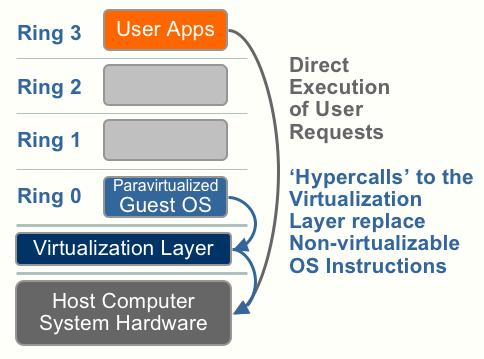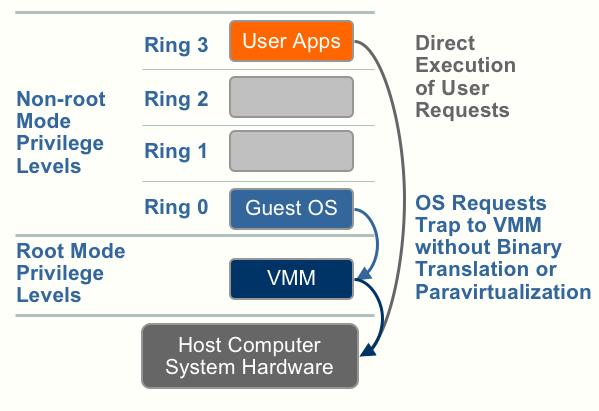Early virtualization efforts relied on software emulation to replace hardware functionality. But software emulation can be a slow and inefficient process. Because many virtualization tasks were handled through software, VM behavior and resource control were often poor, resulting in unacceptable VM performance on the server.
Processors lacked the internal microcode to handle intensive virtualization tasks in hardware. Both Intel Corp. and AMD addressed this problem by creating processor extensions that could offload the repetitive and inefficient work from the software. By handling these tasks through processor extensions, traps and emulation of virtualization, tasks through the operating system were essentially eliminated, vastly improving VM performance on the physical server.
AMD
AMD-V (AMD virtualization) is a set of hardware extensions for the X86 processor architecture. Advanced Micro Dynamics (AMD) designed the extensions to perform repetitive tasks normally performed by software and improve resource use and virtual machine (VM) performance.
AMD Virtualization (AMD-V) technology was first announced in 2004 and added to AMD’s Pacifica 64-bit x86 processor designs. By 2006, AMD’s Athlon 64 X2 and Athlon 64 FX processors appeared with AMD-V technology, and today, the technology is available on Turion 64 X2, second- and third-generation Opteron, Phenom and Phenom II processors
Intel-VT
Intel VT (Virtualization Technology) is the company’s hardware assistance for processors running virtualization platforms.
Intel VT includes a series of extensions for hardware virtualization. The Intel VT-x extensions are probably the best recognized extensions, adding migration, priority and memory handling capabilities to a wide range of Intel processors. By comparison, the VT-d extensions add virtualization support to Intel chipsets that can assign specific I/O devices to specific virtual machines (VM)s, while the VT-c extensions bring better virtualization support to I/O devices such as network switches.
Three alternative techniques now exist for handling sensitive and privileged instructions to virtualize the CPU on the x86 architecture:
- Full virtualization using binary translation
- OS assisted virtualization or paravirtualization
- Hardware assisted virtualization (first generation)
Full virtualization using binary translation
X86 operating systems are designed to run directly on the bare-metal hardware, so they naturally assume they fully ‘own’ the computer hardware. As shown in the figure below, the x86 architecture offers four levels of privilege known as Ring 0, 1, 2 and 3 to operating systems and applications to manage access to the computer hardware
While user level applications typically run in Ring 3, the operating system needs to have direct access to the memory and hardware and must execute its privileged instructions in Ring 0. Virtualizing the x86 architecture requires placing a virtualization layer under the operating system (which expects to be in the most privileged Ring 0) to create and manage the virtual machines that deliver shared resources.
Further complicating the situation, some sensitive instructions can’t effectively be virtualized as they have different semantics when they are not executed in Ring 0. The difficulty in trapping and translating these sensitive and privileged instruction requests at runtime was the challenge that originally made x86 architecture virtualization look impossible.
VMware resolved the challenge in 1998, developing binary translation techniques that allow the VMM to run in Ring 0 for isolation and performance, while moving the operating system to a user level ring with greater privilege than applications in Ring 3 but less privilege than the virtual machine monitor in Ring 0.
OS Assisted Virtualization or Paravirtualization
“Para-“ is an English affix of Greek origin that means “beside,” “with,” or “alongside.” Given the meaning “alongside virtualization,” paravirtualization refers to communication between the guest OS and the hypervisor to improve performance and efficiency.
Paravirtualization, as shown the picture below, involves modifying the OS kernel to replace nonvirtualizable instructions with hypercalls that communicate directly with the virtualization layer hypervisor. The hypervisor also provides hypercall interfaces for other critical kernel operations such as memory management, interrupt handling and time keeping. Paravirtualization is different from full virtualization, where the unmodified OS does not know it is virtualized and sensitive OS calls are trapped using binary translation. The value proposition of paravirtualization is in lower virtualization overhead, but the performance advantage of paravirtualization over full virtualization can vary greatly depending on the workload
Hardware assisted virtualization (first generation)
Going back to the first descriptions of the processors Hardware Assist capabilities – Hardware vendors are rapidly embracing virtualization and developing new features to simplify virtualization techniques. First generation enhancements include Intel Virtualization Technology (VT-x) and AMD’s AMD-V which both target privileged
instructions with a new CPU execution mode feature that allows the VMM to run
in a new root mode below ring 0. As depicted in the figure below, privileged and sensitive calls are set to automatically trap to the hypervisor, removing the need for either binary translation or paravirtualization. The guest state is stored in Virtual Machine Control Structures (VT-x) or Virtual Machine Control Blocks (AMD-V).
Processors with Intel VT and AMD-V became available in 2006, so only newer systems contain these hardware assist features.
Vmware Document describing Full Virtualization, Paravirtualisation and Hardware Assist
http://www.vmware.com/files/pdf/VMware_paravirtualization.pdf




